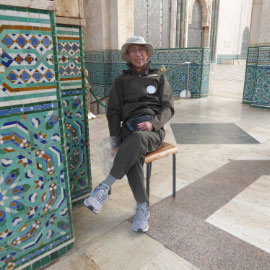
Grand Mosque
|
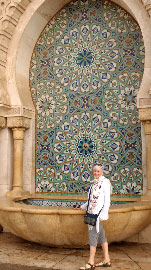
Grand Mosque |
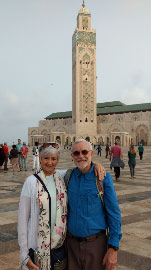
Grand Mosque |
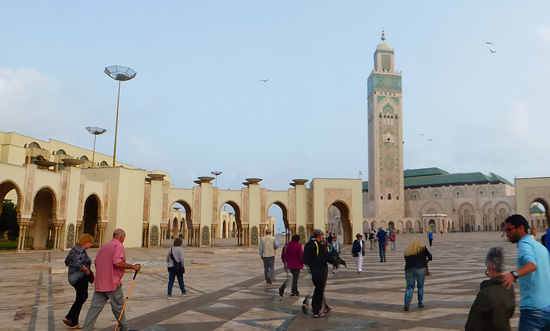
Grand Mosque
|
NOTE: The panaramic photo (above) was easy to take with my new camera. Thanks to my little Panasonic LUMIX with a cool panarama function, the spirit of this old has-been photographer is alive again.
We joke around with our pals Bob and Joan, and get acquainted with our new traveling buddies and of course, all of us fall in love with Nour, our guide. He’s funny, personable, and attentive and has a loving vibe about him.
We get back on our fancy bus and head to Chefchauen a quaint little town nestled in the mountains of northern Morocco.
Most of us jet-lagged weary travelers fall asleep right after Nour makes his first announcement – and a very important announcement. “It costs 2 dirham (20 cents) to use the bathrooms in Morocco.” Money conversion should be easy because $1 US is about 10 dirhams.
A couple of hours later, we stop at a simple roadside diner for a great lunch – veggie, meat, lentils tagine with homemade bread. Excellent!
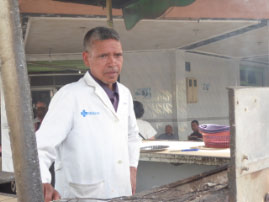
Lunch at Roadside Diner |
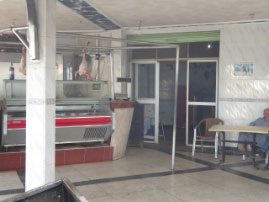
Lunch at Roadside Diner |
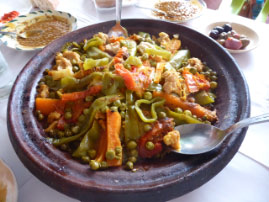
Lunch at Roadside Diner |
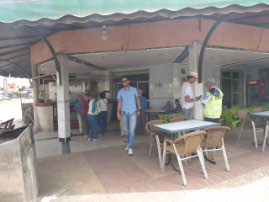
Lunch at Roadside Diner |
Back on the bus, I intermittently doze as I watch the terrain go from flat to rolling hills covered with poppies and other spring flowers with the occasional heard of meandering goats. Finally, Nour stops the bus outside Chefchaouen so we can see the beautiful little town perched on the foothills of the Rif Mountains.
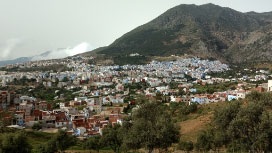
Chefchaouen |
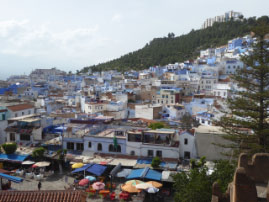
Chefchaouen |
Chefchaouen is picturesque little town with a population of 45,000. All the buildings are painted either white or blue and topped with red tiled roofs. The town was founded by the Berbers in 1471 and then occupied by Jews and Muslims in 1494. Christians were forbidden to enter under penalty of death for almost 500 years until the town was occupied by Spain in 1920. Casablanca is very French with everyone speaking Arabic and French, but here in Chefchaouen, Spanish replaces the French.
We drive through narrow, winding streets to the center of town which happens to be at the top of a hill. There is no place to park our big bus, so we jump out and head uphill to the Casa Hassan Guesthouse. Stepping out of that bus and into the town is like stepping into a picture postcard – mind blowing -- can’t believe we’ll be here for three days!
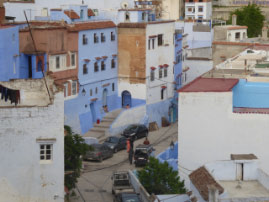
Chefchaouen |
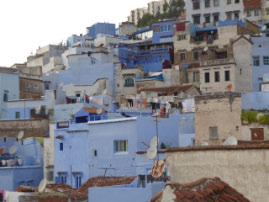
Chefchaouen |
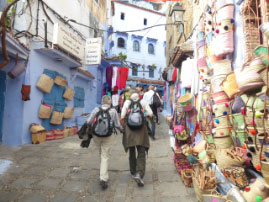
Chefchaouen |
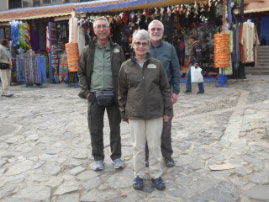
Chefchaouen |
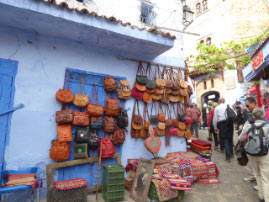
Chefchaouen |
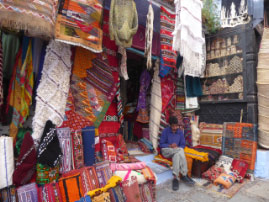
Chefchaouen |
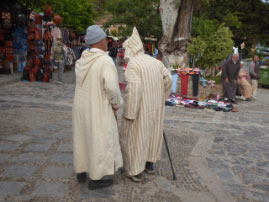
Chefchaouen |
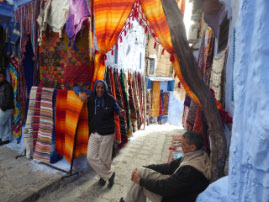
Chefchaouen |
Casa Hassan Guesthouse is magical. I adore the tranquility and elegance of these old mansions that morphed quietly into guesthouses. The lobby occupies the once open mansion courtyards and I can only speculate what our tucked away room must have been used for.
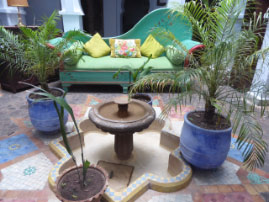
Casa Hassan Guesthouse |
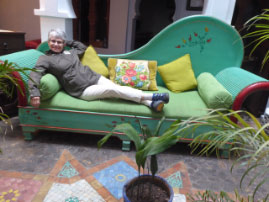
Casa Hassan Guesthouse |
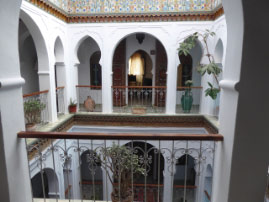
Casa Hassan Guesthouse |
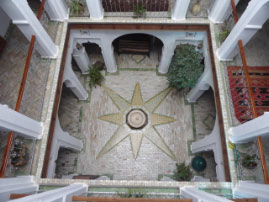
Casa Hassan Guesthouse |
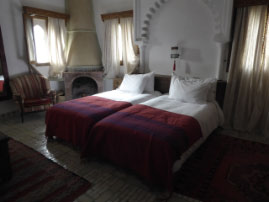
Casa Hassan Guesthouse |
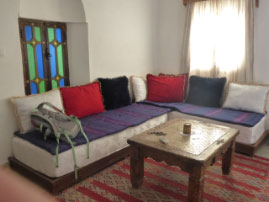
Casa Hassan Guesthouse |
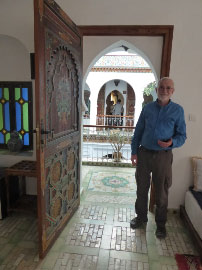
Casa Hassan Guesthouse |
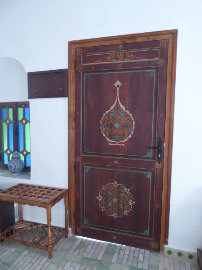
Casa Hassan Guesthouse |
I run around the room in a highly excited state, snapping pictures while Bill just wants a little peace and quiet. The pictures below are taken from our room. The people on the street below provide great entertainment for me.
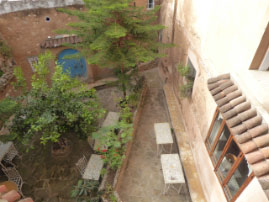
Chefchaouen |
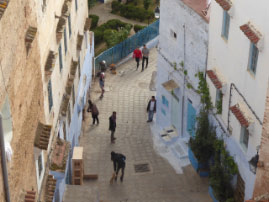
Chefchaouen |
We unpack and settle into our amazing room; then head for a beer with Bob and Joan at the Hotel Parador, about the only place in town that serves alcohol. Happy Hour is tough (and expensive) in a Muslim country. We enjoy the cold beer and the magnificent view. Later, we join the group for a fabulous dinner. Feeling fat and happy, some of us duck into a cozy, tucked away coffee place for some amazing music and a very friendly cat. The Berber music touches my soul. The musicians played with such abandonment – joyful and yet raw. Their effect on me is difficult to describe. Sitting in that little café, I think to myself, “Damn, this is why I travel.”
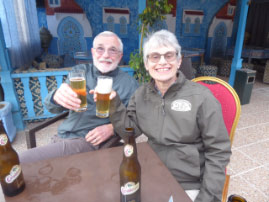
Chefchaouen |
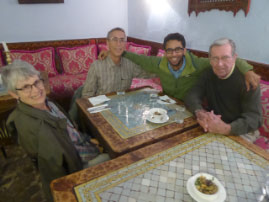
Chefchaouen |
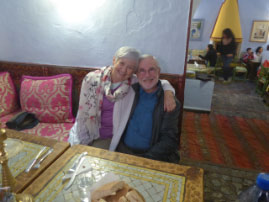
Chefchaouen |
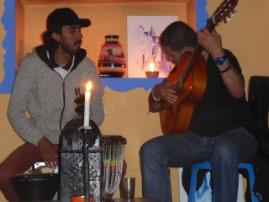
Chefchaouen |
Sunday, April 23 – Chefchaouen
We have an early breakfast. There is a pushy group at the buffet to contend with. Someone takes Bill’s orange juice and toast – it can get ugly. I play it safe and go for the Berber faire, which is easier to get at – fresh bread, goat cheese, honey and coffee. Really love our guesthouse – just hope that annoying group leaves today.
At 8:30, we go for an early morning walking tour of Chefchaouen. The morning atmosphere is calm and quiet, except for the occasional gaggle of loud Japanese armed with their cameras and selfie sticks.
We see some local women (and a few men) painting the buildings while cats pose peacefully in the background. There are lots of cats in Morocco, but very few dogs. Cats are accepted and useful for catching mice while dogs are not. The walk was filled with magical moments -- I’ll let the pictures speak for themselves.
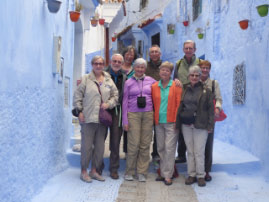
Chefchaouen |
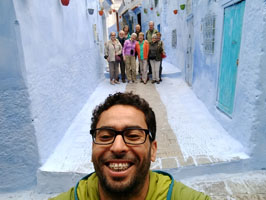
Chefchaouen |
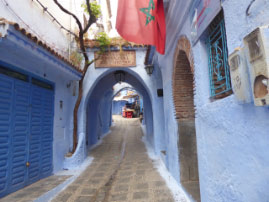
Chefchaouen |
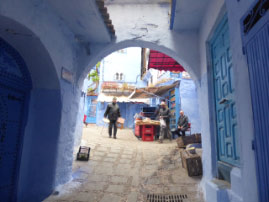
Chefchaouen |
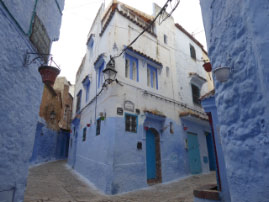
Chefchaouen |
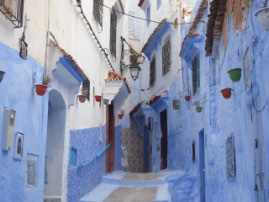
Chefchaouen |
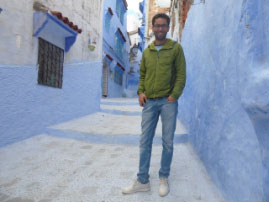
Chefchaouen |
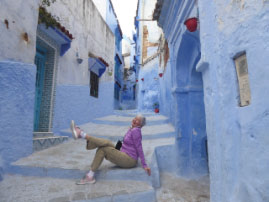
Chefchaouen |
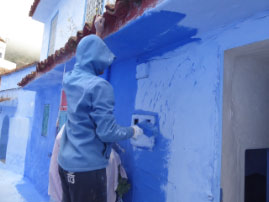
Chefchaouen |
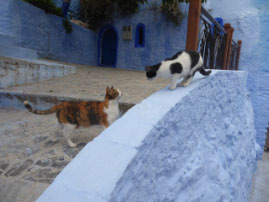
Chefchaouen |
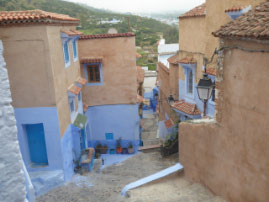
Chefchaouen |
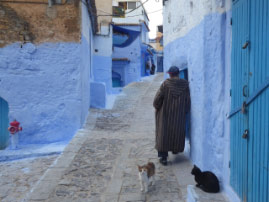
Chefchaouen |
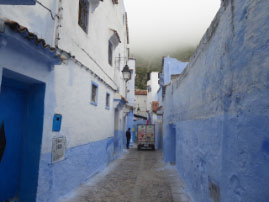
Chefchaouen |
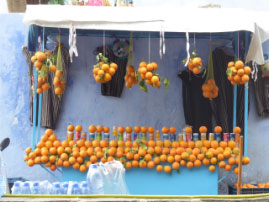
Chefchaouen |
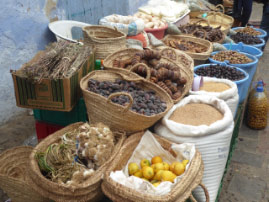
Chefchaouen |
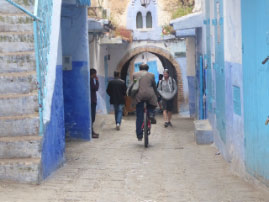
Chefchaouen |
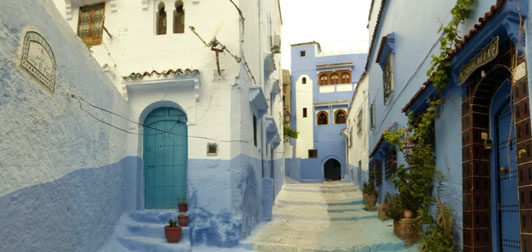
Chefchaouen
|
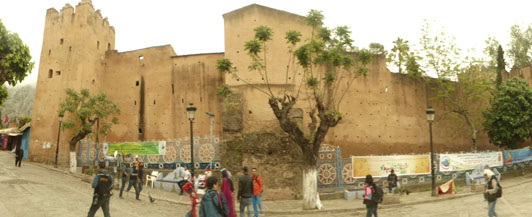
Chefchaouen
|
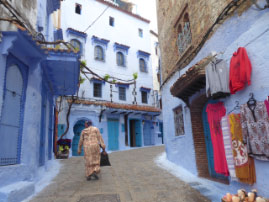
Chefchaouen
|
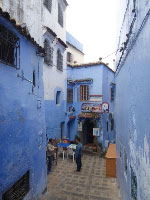
Chefchaouen
|
We continue our stroll down the hill just as the town is waking up. We walk through one of the town’s five main gates and along a stream. Uphill the water is used for drinking; downhill, the stream becomes a public place for the locals to wash their clothes, and now, they’re washing their winter blankets. Along the path, Nour points out an old irrigation system, still in use, and a bridge built by Hassan II. It was a lovely, interesting walk.
At 10:30, we board the bus and head to Houmar, a little mountain village in the countryside. There we have a cooking lesson followed by a home-hosted lunch. In spite of the language barrier, it is easy to get to know the family. The star of the family is a spunky eleven-month old toddler who charms us all. Grandpa is particularly smitten by her. He holds and plays with her while he takes charge of his tea-serving duties. Grandma, age 52, is busy taking care of the rest of the duties with a trio of very friendly, in-charge daughters and a few scattered sons and/or sons-in-law.
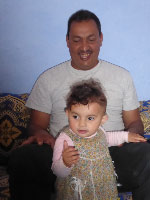
Grandpa and Toddler |
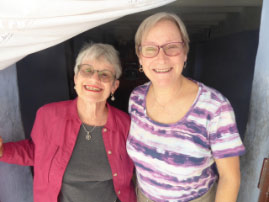
Happy Americans |
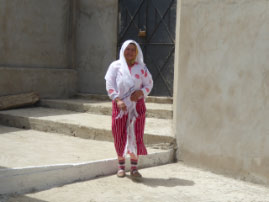
Grandma |
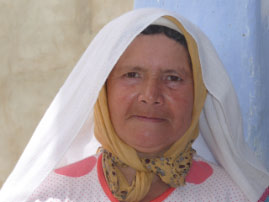
Grandma |
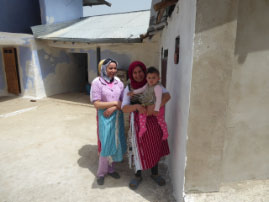
Houmar Village Family |
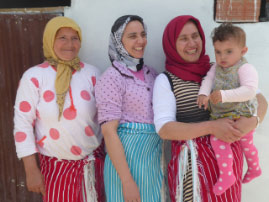
Houmar Village Family |
The original house was built about 50 years ago, more than likely as a community effort. More rooms are added as new family members come along. The treasured family cabinet, sitting on the dirt floor, holds the family plates, glassware and various knickknacks. The kitchen, constructed with no concept of building codes, is a happy place.
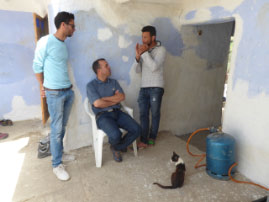
Home Visit in Houmer Village |
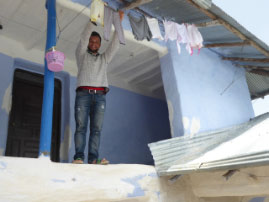
Home Visit in Houmer Village |
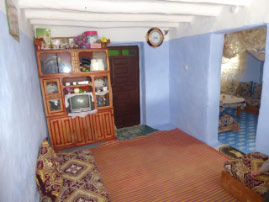
Home Visit in Houmer Village |
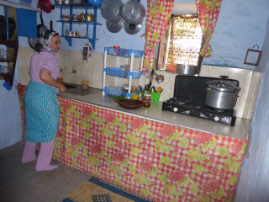
Home Visit in Houmer Village |
Out back is a baby goat, a kitten, and a garden that needs tending – with an incredible view of the mountains in the background.
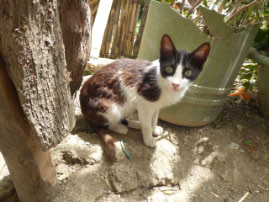
Home Visit in Houmer Village |
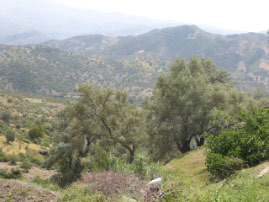
Home Visit in Houmer Village |
Our group tries to help prepare the lunch. Shelling fava beans is our number one activity. At lunch we have the freshest of salads with vegetables right from the garden and the meat is out of this world. Everything is good, except for the fava beans – a little chewy.
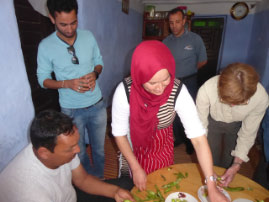
Home Visit in Houmer Village |
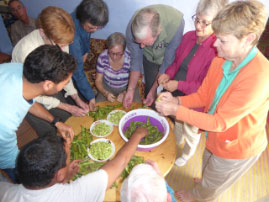
Home Visit in Houmer Village |
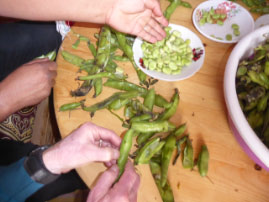
Home Visit in Houmer Village |
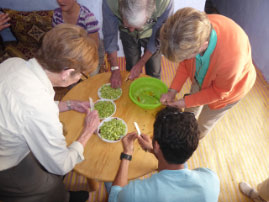
Home Visit in Houmer Village |
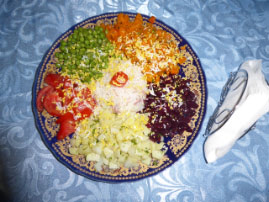
Home Visit in Houmer Village |
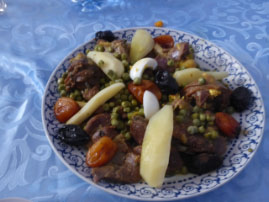
Home Visit in Houmer Village |
It is a delightful, leisurely lunch with fun and laughter. We say our good-byes and walk through the village to our bus. We are the talk of the town – not many of us Westerners here. It’s an isolated town -- no big cities or colleges nearby. Most kids drop out of school after the 6th grade to help on the farm.
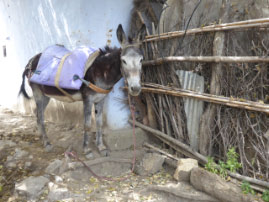
Home Visit in Houmer Village |
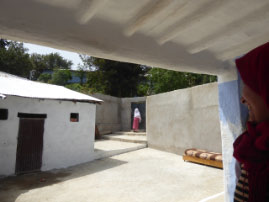
Home Visit in Houmer Village |
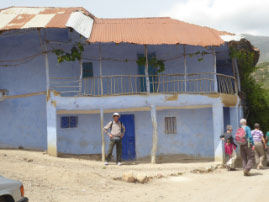
Home Visit in Houmer Village |
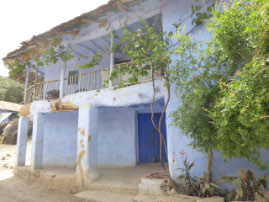
Home Visit in Houmer Village |
The Moroccan government heavily subsidizes people who want to become farmers. Farmers have a difficult time making a living.
A lot of the farmers grow cannabis (marijuana) just to keep afloat. Although growing cannabis is illegal, officials look the other way, if the unofficial bribe money is paid each month. Farmers can make a little from the cannabis crop – enough to keep the farm going. It’s the middle men who make all the money in the “pot business.”
We take the bus back to Chefchaouen. Bill washes clothes while I journal until “Happy Hour.” Some cold Casablanca beer at the Hotel Parador is waiting for us. We like Casablancas, the locally crafted beer.
We meet the group for dinner. It’s a chilly night – glad I brought my down jacket. Nour takes us to his favorite haunt – cheap and local and very, very good. $8 bucks gets you an unforgettable delicious dinner. There is fun and laughter as I document the warm, happy place with my panoramic photos.
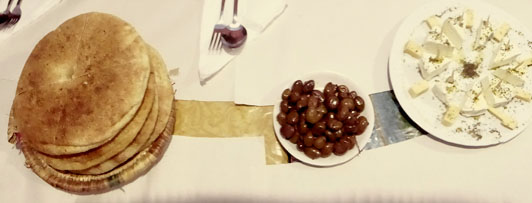
Dinner in Chefchaouen
|

Dinner in Chefchaouen
|
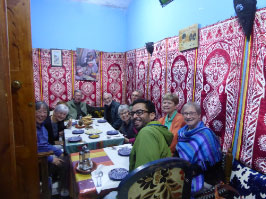
Dinner in Chefchaouen |
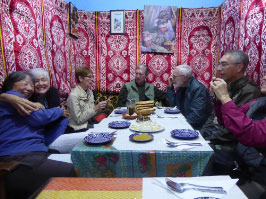
Dinner in Chefchaouen |
Monday, April 24 – Chefchaouen –Tour to Tetouan
Breakfast at the hotel is quiet and civil – the group from hell is gone. The morning is cool and drizzly. We sign up for the optional tour to Tetouan. The bus passes through more of the same hills covered with goats and flowers, making a coffee stop along the way.
Tetouan is a city in northern Morocco and one of the two major ports. It’s close to Tangier and just a few miles south of the Strait of Gibraltar. Although its medina (old town center) is on the World Heritage List of the UNESCO, we are disappointed in Tetouan.
We arrive in the town and meet our guide, Samir. We first stop at a big square where he points out the local royal palace. The king doesn’t stay here often; nonetheless, he’s still got a big palace here with lots of armed guards out front. It’s like all the other palaces and guards he has in pretty much any major Moroccan city.
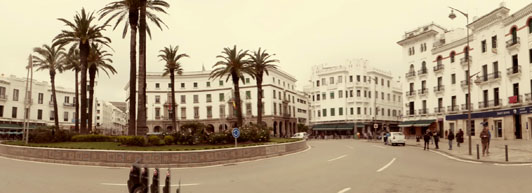
Tetouan
|

Tetouan
|

Tetouan
|
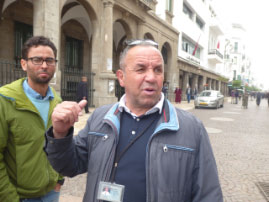
Tetouan |
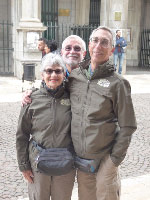
Bill, Joan and Bob in Tetouan |
We stop at the post office and end up spending a lot of time there trying to buy stamps. The postal clerk had not encountered such a complicated transaction in years – painful experience – hope we didn’t make him “go postal” after we left.
Samir walks us through the medina. There are a lot of small narrow lanes with lots of small shops with vendors selling all sorts of stuff – from fruits, meats, and spices to jewelry and carpets. The place is overwhelming. It reminds me of the market in old Jerusalem.
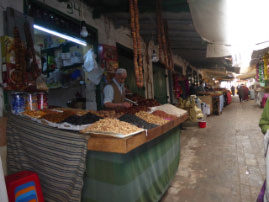
Tetouan |
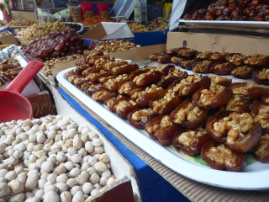
Tetouan |
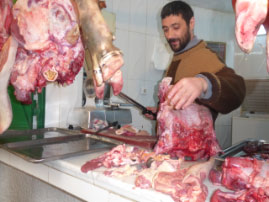
Tetouan |
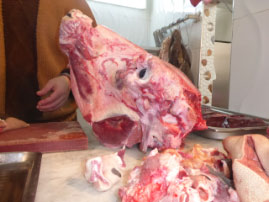
Tetouan |
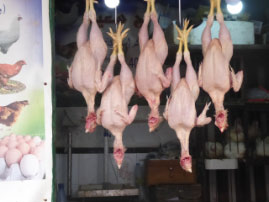
Tetouan |
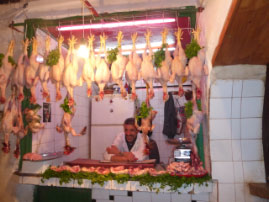
Tetouan |
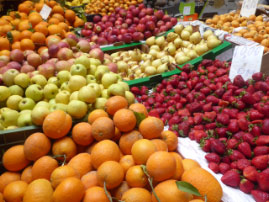
Tetouan |
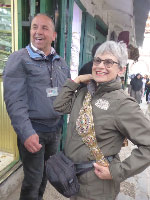
Joan and Samir |
Down one narrow twisty lane, we stop in at the one Jewish synagogue – The Isaac Ben Walid Synagogue, built during the beginning of the 19th century – and the only one left in town. Once there were 17,000 Jews in town – now it’s down to 12 folks so services aren’t held very often.
Our last stop in the town is at a trade school for kids learning a craft. Samir explained that the trade school is for “kids who aren’t very lucky in their studies.” (Now that’s a politically correct phrase!)
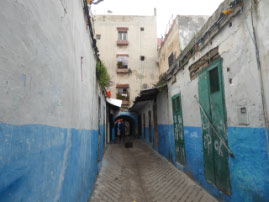
Jewish synagogue |
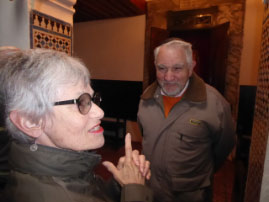
Jewish synagogue |
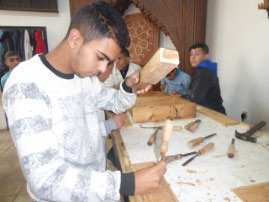
Craft School |
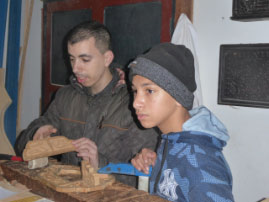
Craft School |
We take a different route back to Chefchaouen – via the Mediterranean Sea, stopping for fish at a place overlooking the sea. It was not very impressive – the fish was boney and the fries were cold.
On the last leg of our trip back to Chefchaouen, we go through spectacular gorges and rivers.

Spectacular Gorges
|

Spectacular Gorges
|
Back in town, we visit the fortress built in 1471 by the town’s founder Mullah Ali Ben Moussa. It is a Moorish fortress originally for exiles from Spain. Over the centuries, the city grew and later welcomed Jews and Christian converts alike.
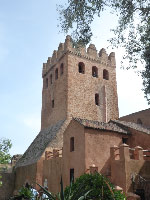
Moorish fortress |
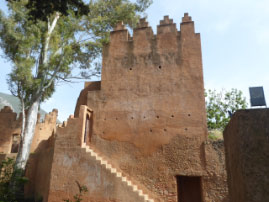
Moorish fortress |
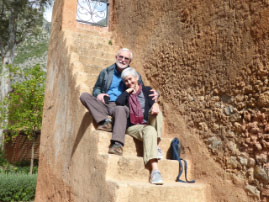
Moorish fortress |
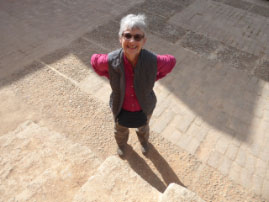
Moorish fortress |
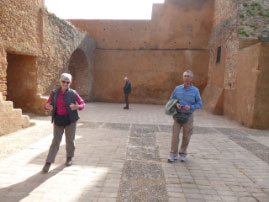
Moorish fortress |
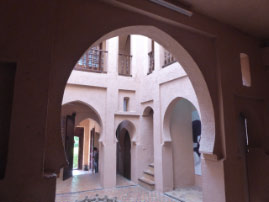
Moorish fortress |
From the high towers of the fortresses, I capture wonderful vistas of Chefchaouen. Then, on our walk back to the hotel, I snap a couple of “panoramics” – I’m going to miss this place.

Chefchaouen |
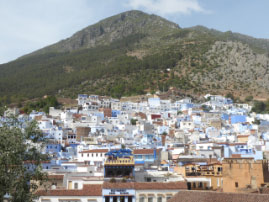
Chefchaouen |
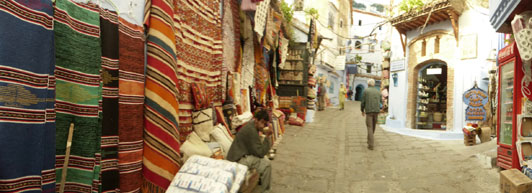
Chefchaouen
|
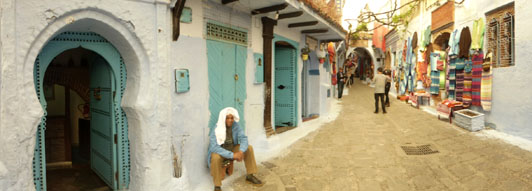
Chefchaouen
|
We meet Fatima at the hotel to get an insight into modern life as a woman in Morocco. She is very cool and outspoken. She studied English Literature and is married with two teenage boys. She helps young girls in Morocco continue their education. Most girls in the countryside marry at 16 – 18 and start their families – and miss their chance at an education and a decent life.
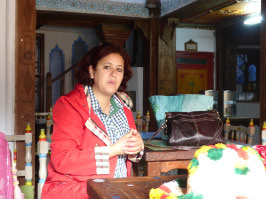
Fatima
|
For dinner, we return to the same restaurant we ate the night before. I have fresh mushrooms gathered that very afternoon. Served with homemade bread and goat cheese (well known in this area), I am a very happy Berber.
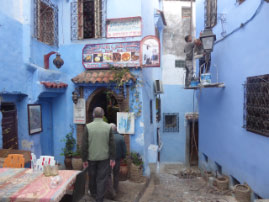
Dinner in Chefchaouen |
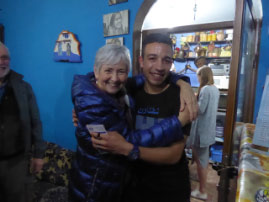
Nancy and waiter |
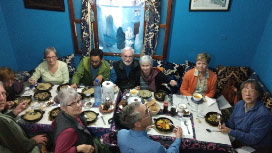
Chefchaouen
|
Tuesday, April 25 – Chefchaouen to Tangier
We spend the morning on the bus driving through the mountains to Tangier with a coffee and potty stop along the way.
Thinking it would like be Tijuana, I am prepared not to like Tangier, but my opinion quickly changes. Probably in anticipation of the King’s arrival, there are miles of freshly planted flowers along the road into Tangier. I’m sure I get more pleasure seeing them than the King.
Our hotel rooms aren’t available until 3 p.m., so we drive up into the hills north of the city. We tour the grandiose neighborhood with embassies and mansions and even the King’s summer home – all built with oil money and corruption (maybe I’m a little jaded).
Right before we reach the Atlantic Ocean, we hang a left that takes us to Hercules Caves, a main attraction. The name is taken from the Roman legend because it’s believed that Hercules slept in one of the caves before he went off to accomplish some super hero feat.
The cave’s opening to the sea looks like "The Map of Africa," thought to be created by the Phoenicians. The cave itself is part natural and part man-made. The man made part was created by the Berber people when they cut stone wheels from the walls. Milling the stones greatly expanded the cave. The stone wheels harvested from the cave were used to make millstones (or grinding stones). The cave shows evidence of Neolithic occupation. Before it became a tourist attraction, the cave served as a brothel. I found the cave eerie and captivating.
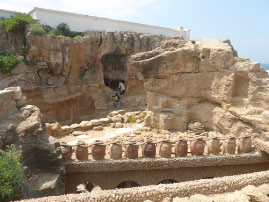
Hercules Caves |
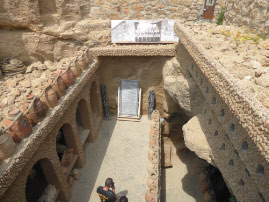
Hercules Caves |
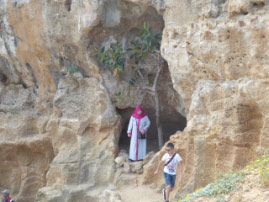
Hercules Caves |
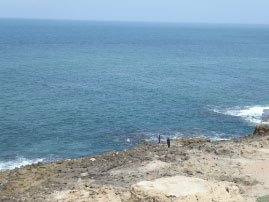
Hercules Caves |
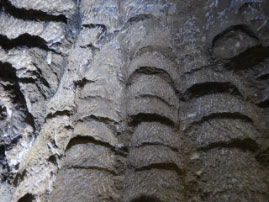
Hercules Caves |
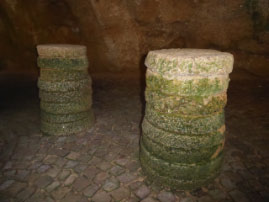
Hercules Caves |
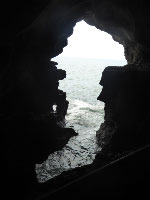
The Map of Africa |
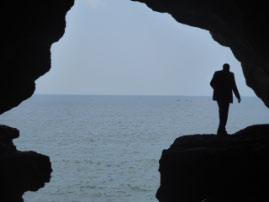
Hercules Cave |
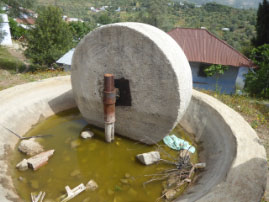
Hercules Cave |
The Lighthouse at Cap Spartel is only a mile or so from the cave. Built in 1864 by Sultan Mohammed III, it’s at the most North Western point of mainland Africa, where you can see the turquoise waters of the Mediterranean Sea merging with the dark blue Atlantic Ocean. The parking lot is loaded with vendors. I buy a couple of toy camels for my younger friends back in the states.
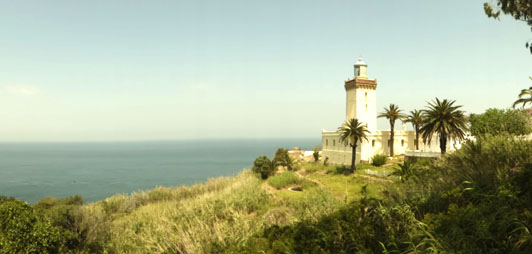
Lighthouse at Cape Spartel |
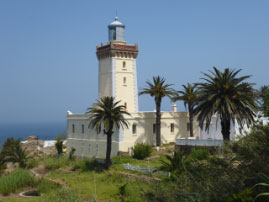
Lighthouse at Cape Spartel |
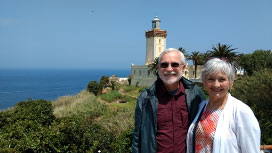
Lighthouse at Cape Spartel |
We drive back to the city and have lunch. I order the chicken kebob – always a safe bet.
After lunch, we check into our hotel – RIF Atlas Hotel and SPA – nice place. All our rooms have great views overlooking the sea.
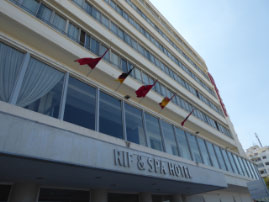
RIF Atlas Hotel and SPA |
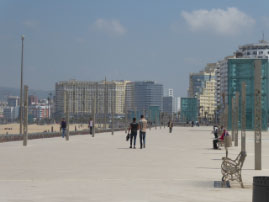
Tangiers Beach |
Later, we meet our guide, Syed, for a walking tour. Syed is not very good at walking – rather large and out of shape, but he is excellent at talking. A real storyteller, he shares stories about ex-pats who once called Tangier home -- Barbara Hutton (actress of the “Poor Little Rich Girl” fame), the original Tarzan actor, Henri Matisse, Tennessee Williams, Rolling Stones, and the list goes on.
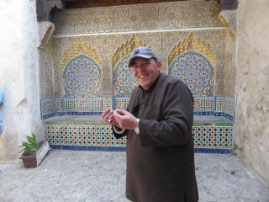
Syed, Our Tangiers Guide |
People have been living in Tangier since colonists from Carthage settled here in the 4th Century BC. The area has changed hands between several kingdoms and empires and always served as a refuge for many. At the turn of the century, it became THE PLACE for laundering money, avoiding taxes, dodging the law, or just getting away from it all. It was, and still is, an exotic cosmopolitan area offering a quick escape to and from Spain.
We start our walk at the Kasba (city wall) which was destroyed in the 1755 Lisbon earthquake and tsunami, killing approximately 30,000 people – and Tangier is a long way from Lisbon. Some of the sections of the wall were rebuilt. We enter one of the city’s gates and meander through the medina (old town) with its narrow streets and many shops. Syed points out the old mansion where Barbara Hutton threw lavish parties. We also see the exquisite wall Matisse painted and The Grand Café in the crowded central square where Tarzan was arrested and charged with murdering his wife.
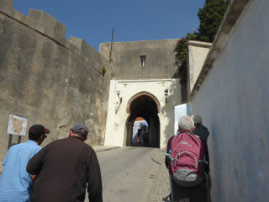
Tangiers Kasba |
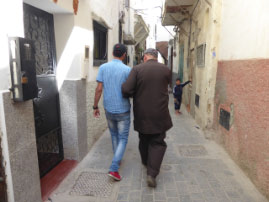
Tangiers Kasba |
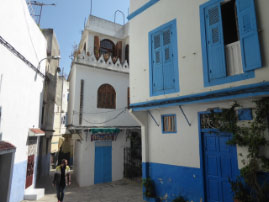
Tangiers Kasba |
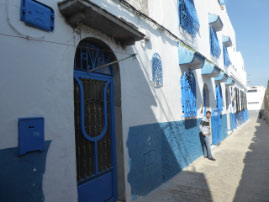
Tangiers Kasba |
I am fascinated by the classy doors and interesting door knockers. Many were fashioned as the Hands of Fatima, (the daughter of the Prophet Muhammad). Syed tells us that they were a sign of protection, also known as the Hamsa, used by both Jews and Muslims to provide defense against the evil eye.
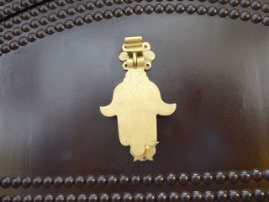
Tangiers Kasba |
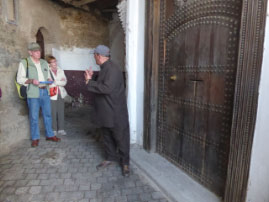
Tangiers Kasba |
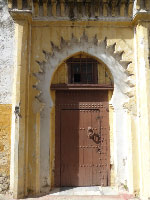
Tangiers Kasba |
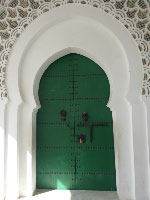
Tangiers Kasba |
Syed shows us the exquisite wall (part of the town’s fountain) painted by Matisse – amazing! Can’t believe he lived here and came down to paint the gate. It’s easy to tell that he was greatly influenced by the Muslim designs and patterns.
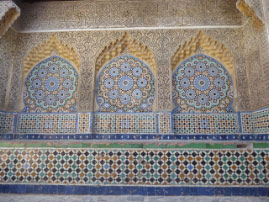
Matisse Fountain |
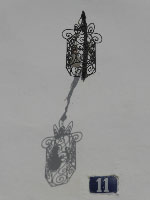
Tangiers Kasba |
Pictured below (building on the left) is where Barbara Hutton lived and threw lavish parties. She was heir to the Woolworth fortune and also a famous movie star. Dubbed as the "Poor Little Rich Girl," the wealthiest women in the world lived a sad sack life. Her mother died when she was five. She was exploited by several men including her 7 husbands. She lost her only child in a plane crash when he was 36. Publicly she was envied for her possessions, her beauty and her apparent life of leisure, but privately she remained deeply insecure, often turning to drink, drugs, and playboys. She tried to buy love and it just didn’t work out for her. Syed said she died at age 66 of a heart attack with only $55 to her name. I think she died of a broken heart.
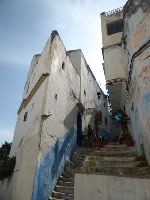
Barbara Hutton's House |
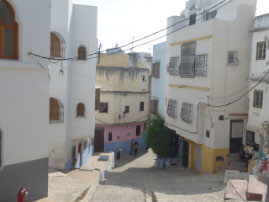
Barbara Hutton's House |
The Grand Café, pictured below is where the displaced wealthy ne’er-do-wells on the run, or just plain drop-out expats (e.g., gangsters, stars, artists) gathered for coffee. Syed said one day the police busted in and arrested Tarzan and charged him for murdering his wife. If these walls could talk!
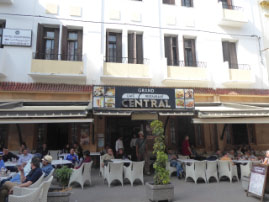
Grand Cafe |
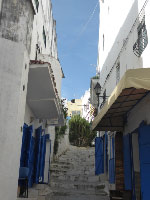
Tangiers Kasba |
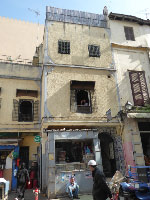
Tangiers Kasba |
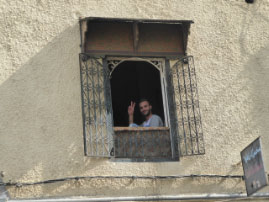
Tangiers Kasba |
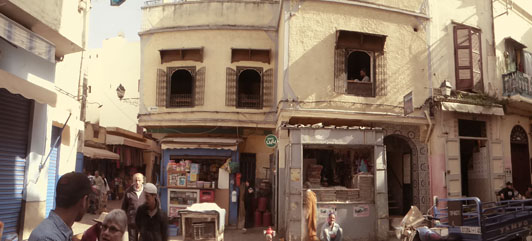
Tangiers Kasba |
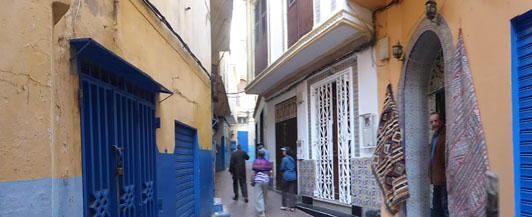
Tangiers Kasba |

Tangiers Kasba |

Tangiers Kasba |
Finally, we stroll down by the harbor where the city is separated from the Strait of Gibraltar (in Europe) by only 9 miles. There are lots of day-trippers arriving on ferries, pouring in from Spain, seeking a more exotic experience than anything they can find in Europe. After our packed morning, Bill is happy to rest and check his Facebook to see what’s happening in Cambodia.
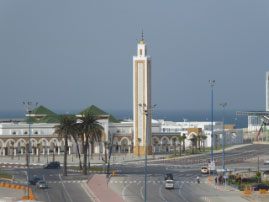
Tangiers Harbor |
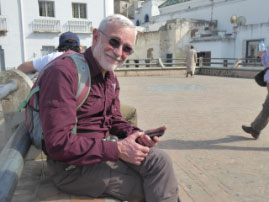
Bill at Tangiers Harbor |
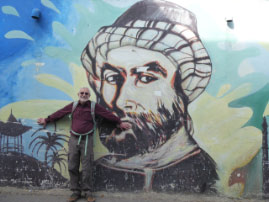
Tangiers Harbor |
We return to the hotel for Happy Hour and then gather at your typical hotel. I sit by Nour which makes for a lovely evening.
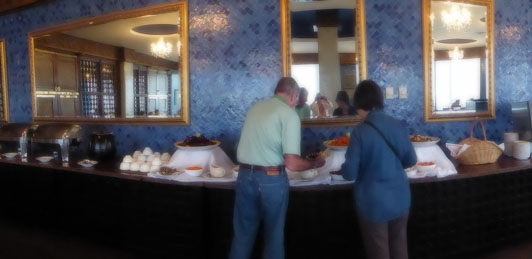
Tangiers Harbor |
Back at the room I journal, then turn on CNN. More bad news – Tramp wants to bomb North Korean. Lord have mercy on us all.
Wednesday, April 26 – Tangier to Rabat
We hop on the bus and travel south a couple of hundred miles to Rabat. Rabat is one of Morocco’s ancient imperial cities and its capital since 1913. It’s a very clean cosmopolitan city with lots of history.
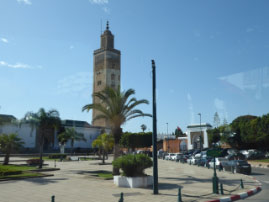
Rabat |
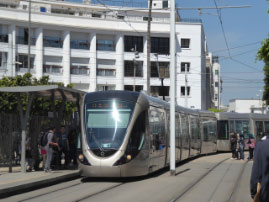
Rabat |
We have lunch on our own at the AYA Rosa café where the locals dine. Chicken panini and tea go down well.
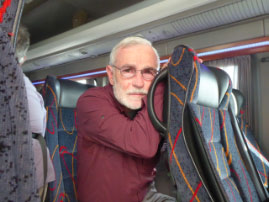
Rabat |
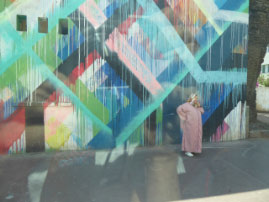
Rabat |
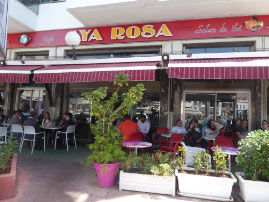
Lunch at Ya Rosa |
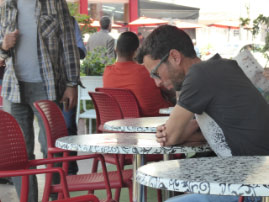
Lunch at Ya Rosa |
After lunch, we check into the Le Diwan Hotel.
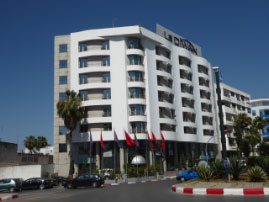
Le Diwan Hotel. |
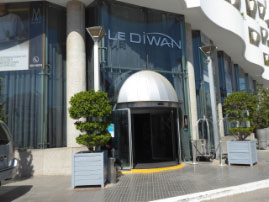
Le Diwan Hotel. |
We spot a poster for a Picasso art exhibit at the Mohamed VI Museum of Modern and Contemporary Art. We’re suckers for Picasso so we walk down to the museum. Unfortunately, the exhibit is a week late so we have a look at the African Art. Moroccan Art has a different flare that tickles my fancy in a strange way.
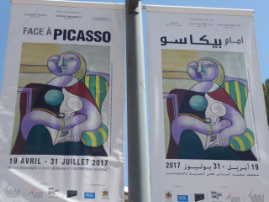
Mohamed VI Museum of Modern and Contemporary Art |
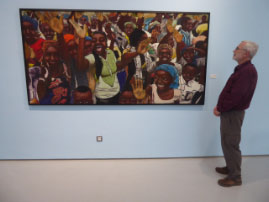
Mohamed VI Museum of Modern and Contemporary Art |
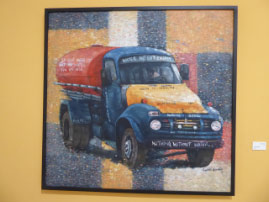
Mohamed VI Museum of Modern and Contemporary Art |
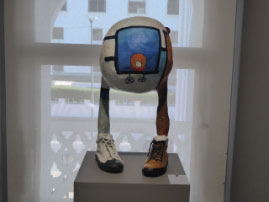
Mohamed VI Museum of Modern and Contemporary Art |
We go back to the hotel for Happy Hour. (It’s rare that a hotel serves beer – but hotels in cosmopolitan Rabat are more open.)
The pre-trip is over and now the rest of our traveling mates arrive to join us on the regular trip, most of them jet lagged. It’s good to see Kathy and Rex again.
We drive down to the Bou Regreg River separating the cities of Rabat and Sale, and then flows out into the Atlantic Ocean. Salé is becoming a fast growing model city attracting lots of attention and visitors. We have dinner in a boat docked on the river that does not float with waiters who do not serve. It’s a ghastly experience. The entrée was cold fish (I mean really cold) and cold veggies. (I’m sure OAT will not be booking them again.) After that subpar dining experience, we nicknamed the restaurant “The Place of Cold Fish.”
| 










